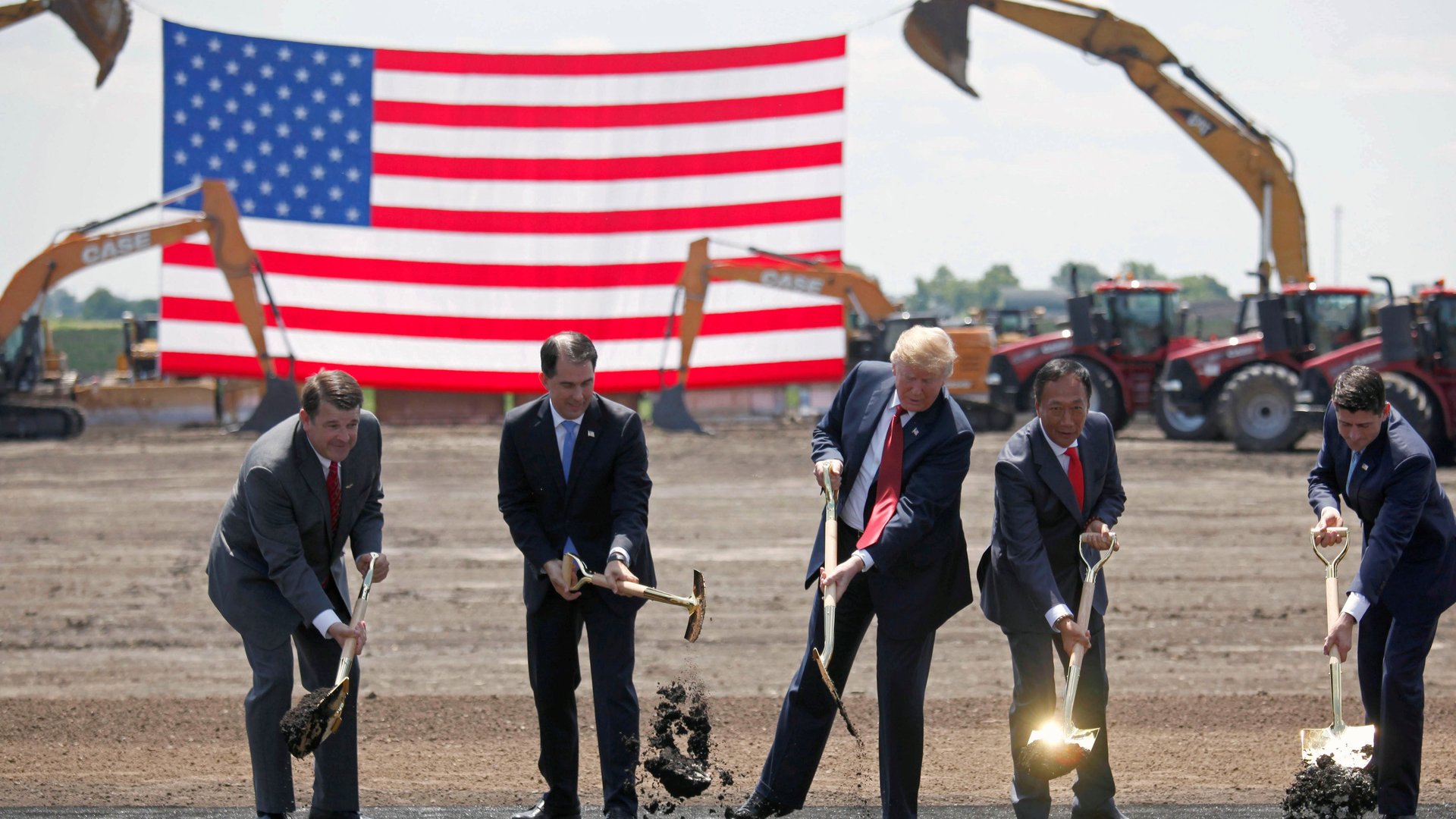Will Foxconn’s new Wisconsin mega-factory deliver for America?
Donald Trump opened a new manufacturing facility in Wisconsin with a golden shovel on Thursday, flanked by state governor Scott Walker, congressman Paul Ryan, and Foxconn chairman Terry Gou.


Donald Trump opened a new manufacturing facility in Wisconsin with a golden shovel on Thursday, flanked by state governor Scott Walker, congressman Paul Ryan, and Foxconn chairman Terry Gou.
The men stood on the bare earth in front of a giant American flag suspended from two huge pieces of heavy machinery. They ceremoniously shoveled dirt in front of them, as an audience that included the US secretaries of Treasury, Commerce, and Labor, as well as Trump’s daughter, Ivanka, and husband Jared Kushner, clapped. “It’s a great honor to have you here,” Trump told Gou, whose Taiwan-headquartered electronics company is best known for making iPhones.
Wisconsin’s Foxconn facility, which will make liquid crystal display screens for televisions and computers, is the first step in a plan to create “Wisconn Valley,” a high-tech manufacturing hub in the low-tax state. It’s also a sign of what’s to come across the US, Wilbur Ross, the Commerce Secretary, said in an op-ed in the Racine County, Journal Times today, as the “U.S. consumer electronics manufacturing sector” is rebuilt across the US.
There was plenty of skepticism last July, when the Foxconn investment was first announced, about the administration’s pledge that it would bring 13,000 jobs and, more generally, boost US manufacturing. Since then, events have made those goals and the broader “Wisconn Valley” plans even more difficult to attain. Here are some of the key challenges:
More sweeteners for the company
The deal has become more expensive for Wisconsin taxpayers. Originally, they were on the hook to give Foxconn about $3 billion in tax credits and other incentives, over the course of the entire $10 billion investment—an amount that Quartz calculated earlier translates into $230,000 per job, if the maximum number of 13,000 jobs were created.
The state has since pledged another $134 million in highway improvements near the facility as a lure, and the local city and county added $764 million in incentives, the Wall Street Journal reports, for a total of nearly $4 billion. That’s $307,692 per job—for jobs that have an average salary of $54,000. Or looking at it another way, it’s going to take Wisconsin workers nearly six years to earn as much from Foxconn as the community is losing in tax credits and additional spending to support the facility. One government analysis suggests it won’t make the state money until 2042.
The government benefits Foxconn will get are “linked to Foxconn’s performance in terms of job creation and the capital investments that we have committed to make,” the company said in response to questions from Quartz.
Greater reliance on robots
Earlier this month, Foxconn’s Gou reiterated a pledge to push for more automation, and said that robots will replace up to 80% of the company’s approximately one million workers in the next five to 10 years.
Foxconn told Quartz that it is “committed to creating 13,000 high-value jobs, at an average annual salary of $53,875, and investing $10 billion in our campus in Wisconsin.” In addition, the company said, “potentially thousands more jobs will be created in Wisconsin by our strategic partners from Asia and the US who will locate their operations at our Wisconn Valley Science and Technology Park.”
Foxconn is using “robotics engineering and other innovative manufacturing technologies to replace the more mundane and repetitive tasks previously done by employees,” Foxconn said, and to allow them to “focus on high value-added elements in the manufacturing process, such as research and development and quality control.” In addition, the company said, it is only replacing workers with robots by attrition, not firing them.
The company has some fully-automated production lines, but most of them use a mix of automated stations and manual operations, it said. “We expect this to continue to be the case in the foreseeable future,” Foxconn added. “We also need employees, such as system programmers, automation engineers and maintenance technicians, working on automated production lines to ensure smooth operations.”
Trade wars and visa hurdles
When Foxconn said last year it would invest big in the US, Trump’s trade wars were merely rhetoric. Since then, the administration has added steep tariffs to imported steel and aluminum. It has also threatened to put tariffs on billions of dollars of Chinese goods, which could potentially affect the cost of raw materials and parts for Foxconn and its network of suppliers in Wisconsin. Foxconn had no comment about how this could impact the factory.
Correction: An earlier version of this story identified Wisconsin’s governor as Steve Walker. His name is Scott Walker.